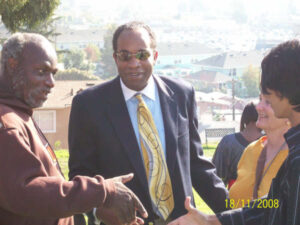In 1971, a young, black man named Stanley Clayton joined Peoples Temple. Homeless at the time, Clayton was drawn to the movement from Oakland. The cousin of Black Panther Huey Newton, Clayton was taken by Jones’ social ideals and equitable message, seeing Peoples Temple as a place where he could find purpose. He, too, may have been drawn by his own need for healing as someone struggling with addiction. Equally, without material security or hopes at a better education, the movement’s communal aspects may have been an appeal. Clayton made the move to Jonestown in 1977. Upon arrival, however, the agricultural project did not meet his expectations. Riled enough to voice his desire to leave over perceived mistreatment, he decided to stay after being convinced by Jim Jones that things would improve. Still, during his time in Jonestown, Clayton appeared prone to acting out and thus found himself as the focus of discipline on a number of occasions.
Like many in the settlement, in the final days of Jonestown Stanley Clayton believed all to be well–especially considering Congressman Ryan’s largely positive response during his visit. As preparations for mass murder-suicide were made on the afternoon of November 18th, Clayton seemed to have wearied of Jones’ constant bombardment of fear. Though working as a part of the kitchen crew at Jonestown, thus making him an early observer of the infamous Koolaid being prepared, Stanley Clayton didn’t think anything to be out of the ordinary, believing the happenings to be a part of another “white night” from which the kitchen staff was usually excluded. It was once Clayton learned everyone was reporting to the pavilion that he knew something was amiss. As one of only seven people to survive the massacre, Clayton escaped by telling guards he wanted to say goodbye to friends before committing suicide, slipping into the jungle. However, before his escape that day, he witnessed the death of his girlfriend and her family, amongst hundreds of other suicides. After hiding in the jungle for hours, he reported hearing cheers and a number of gunshots before the settlement descended into silence. He made his way to Port Kaituma, where contact was made with authorities.
After returning to the United States, Clayton was one of the few former members of Peoples Temple who detailed their experiences extensively to the government and journalists, providing key details for the narratives of The Children of Jonestown, by Kenneth Wooden, and A Thousand Lives, by Julia Scheeres. Though there is little information on his life in the United States after the massacre, what is known of his post-Jonestown experience seems reflect a reversion to pre-Jonestown patterns, spending many of his subsequent years battling drug addiction. Whether correlated or not, having changed his account of the events at Jonestown a number of times, Clayton’s recollection of events is increasingly seen as an unreliable source. He is 68 years old.

Clayton, left, seen here with Jim Jones Jr., center, in 2008 at a 30th Anniversary Memorial Service for Jonestown.
In this video, a traumatized, seemingly despondent, Clayton recounts his final hours in Jonestown.